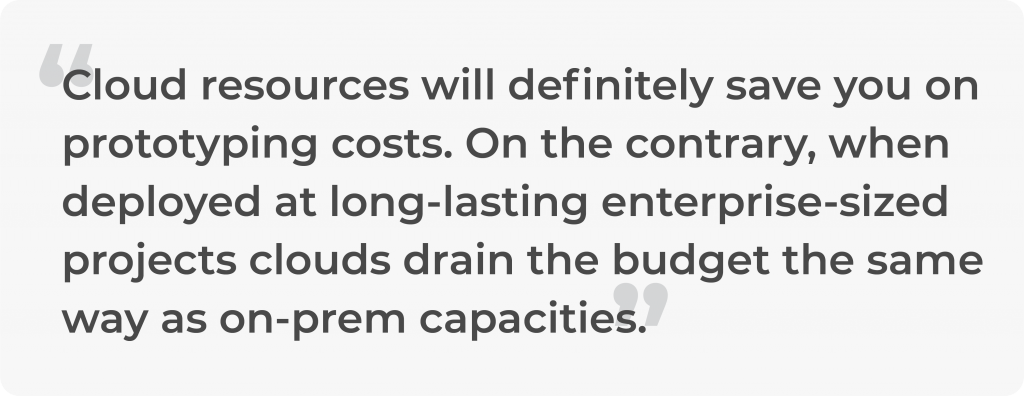Cloud solutions have grown ubiquitous by now. Providers proliferate, starting from small-scale businesses to estimated IT giants, such as Amazon, Microsoft or Google. Your capacities may still be on premises, as long as they serve their purpose well. On the other hand, do not turn the blind eye to ever-growing potential of cloud technologies as these definitely have a lot to offer now.
In case you’re still in between, we’ve gathered some tips for you that will come in handy when you decide on moving to the cloud.
Incentives behind cloud deployment
What causes businesses to move to the cloud? The most common incentives behind cloud deployment are listed below.
- Merges and Acquisitions
Managing numerous on-prem data centers can grow troublesome even within one company. Needless to say, besides revealing untapped profits a merger may induce grave hosting and storage-related problems. To avoid that, enterprises undergoing mergers move their apps and data to the cloud to collectively share common resources. Cloud will also be a huge plus when accommodating new employees and geographies. - Seasonal load shifts
Say, for a consulting or auditing company, seasonal peaks are well-known struggles. Capacity jumps make many of them opt for larger on-prem capacities, which eat up a good deal of budget. By leveraging cloud-based solutions enterprises say bye-bye to seasonal constraints as they can deploy additional capacities at any given moment and pay as they go. - Hardware/software upgrades
Legacy systems die out, so will businesses if they’re behind the speed of technological upgrade. Moving to the cloud to a large extent will relieve a company of its licensing and upgrading duties, as these will be left for a service provider to manage.
In case your business anticipates any similar perturbations, it’s high time you delved deeper into CaaS details. Now as you may learn a lot from others’ experience, start with a cloud solution without running deadly experiments on your business.
What to choose
The options abound. Choose an appropriate cloud service that suits best your business needs.
When IaaS is the best option
When meddling with servers, storage and networking hardware makes your life a living hell, IaaS is there for you, as that is exactly the part a vendor keeps to itself. However, IaaS leaves operating system, VMs, containers, or apps and middleware exclusively for you to cater to. Using IaaS is a lot like running applications in your own data center, except that your in-house IT operations team doesn’t have the burdens of deploying, configuring and maintaining the physical equipment on which your applications run (Datamation). IaaS allows for impressive customization and flexibility due to an extensive range of storage and compute instances. Thus, a client picks a best-suit option tailored to his/her business needs.
To sum it up: It’s a killer option for a fast-growing business with huge appetite for capacities. Now you can deploy deficit storage, networking, servers, and processing power on the go as shortage occurs.
When PaaS is the best option
PaaS unloads a tedious software management task from the customer. A vendor streamlines your development processes by granting access to the tools necessary to build specific apps. Put differently, it is a warehouse of technologies, or an all-you-need-under-one-roof solution. Say, App Service by Microsoft Azure boasts built-in support for .NET, .NET Core, Java, Ruby, Node.js, PHP, and Python. Google App Engine empowers you to write web or mobile apps in Node.js, Java, Ruby, C#, Go, Python, and PHP.
To sum it up: The best advantage of cloud app development is that you, as a developer company, invest your efforts into actual developing without bothering about scalability, maintainability and cost-effectiveness.
When SaaS is the best option
With the entire IT stack handled by the vendor, you can make best use of easily available and reliable software. No tiresome download/install/upgrade-related issues to tackle, infrastructure and software health is left for the vendor to keep an eye on. An investment that is worth its money for it enables unlimited web and mobile access to particular business software.
To sum it up: It is a best option for small businesses that need their system to be launched in no time without centering many efforts on server or software issues.
Besides, you’ll have to choose from a private, hybrid or a public type of a cloud. While private means securing the platform all for your business, public is the opposite to it, with data from multiple companies accommodated side by side within one cloud. Hybrid solution is a compromise between a jaw-dropping price for private clouds and dubious security standards of public solutions. No wonder a sweeping majority of business community prefers hybrid solutions (58% according to RightScale) to a more attack-resilient private option in a world where cost is a catalyst to many trends.
Pitfalls to beware
Although cloud computing has pretty much to afford – additional storing capacities, dev tools specific for your needs, complex software – beware of the pitfalls CaaS may carry.
Question cloud effectiveness
Count your paying dollars as well as working hours spent to deliver. Ideally, deploying a cloud service should cut your costs and ensure a more speedy delivery. Launch a simple Proof-of-Concept (POC) project which should be conducted separately from ‘business as usual’ activities to see clearly your returns. Daniel Bryant states in his article that small dosage of experimenting should be taken by any company willing to introduce cloud computing to its activities.
According to Sergey Pupkevich, Head of Java Solutions Department at Qulix Systems, cloud resources will definitely save you on prototyping costs. On the contrary, when deployed at long-lasting enterprise-sized projects clouds drain the budget the same way as on-prem capacities.
Choose your vendors wisely
Applying “the more you pay, the better” principle may result in outcomes below your initial expectations. Not for nothing, Amazon Web Services boasts an extensive list of services and technologies you can pick from based on how thick your wallet is. On the other hand, wide assortment of an established player bounds your business tightly to a single vendor. Given that, you won’t be free in your strategy planning tied to the all-inclusiveness of, say, Amazon’s offerings. This is the reason why business community opts for multi-cloudness which drives competition and innovation in the industry, however convenient servicing at a single vendor may be.
Get your troops ready
Shifting to the cloud implies you will free your personnel from specific workload to focus on delivering. At the beginning, embracing cloud technologies does require some new learning from your people, but that is comparable to plugging into a new framework. A more meaningful turn, though, will touch upon your recruiting priorities. A headhunt has begun for cloud engineers. To hire genuine experts in cloud engineering is an imperative for any business willing to thrive in the cloud industry, whatever the cost.
Location matters
Cloud technologies grow more advanced with each coming year. Nevertheless, there is still a bunch of territorial issues left unsettled. Say, the further you locate from a cloud server, the poorer the service. Although these milliseconds in delays are hardly noticeable in day-to-day activities, they add up to your list of unnecessary operating costs.
As a contrast to many mid-size vendors, AWS has its data centers in different regions worldwide, so cloud server in any case will be located in acceptable/close proximity to the user. Less fortunate rivals of AWS and other cloud giants cannot afford such extensive coverage, yet they ask less for their services.
Data sovereignty
An even closer demand for details is required to deal with data sovereignty issues. Multiple national laws and regulations impede on unlimited international data sharing of sensitive/personal data. Already enacted European Union’s General Data Protection Regulation (GDPR), China’s Cybersecurity Law (CSL), Brazil’s General Data Privacy Law (LGPD), India’s Draft Data Protection Bill and many more to come in force in the nearest future across the globe, restrict operations in once self-regulated cloud realm. Watch closely where your data goes to rest to mitigate the risk of unavailability or data loss.
Once you’re ready to say “yes” to the cloud deployment, make sure extensive reasoning stands behind it. Rather than a quick, be a wise adopter. If, on the contrary, you’re hesitant to move to the cloud, contact Qulix Systems. We will be happy to do the prototyping part for you so that you were 100% clear about the benefits and implications of the cloud deployment for your company.
Learn more on trends and technologies from our Support team or visit our website.





